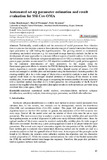Citation link:
http://dx.doi.org/10.25819/ubsi/10123| DC Field | Value | Language |
|---|---|---|
| dc.contributor.author | Bonekemper, Lukas | - |
| dc.contributor.author | Wiemann, Marcel | - |
| dc.contributor.author | Kraemer, Peter | - |
| dc.date.accessioned | 2022-06-03T11:55:41Z | - |
| dc.date.available | 2022-06-03T11:55:41Z | - |
| dc.date.issued | 2020 | de |
| dc.description | Finanziert aus dem DFG-geförderten Open-Access-Publikationsfonds der Universität Siegen für Zeitschriftenartikel | de |
| dc.description.abstract | Traditionally, modal analysis and the extraction of modal parameters from vibration data is a process that requires a more or less extensive amount of manual interaction from setting input parameters up until finding the eigenfrequencies. The growing interest in continuously monitoring mechanical structures e.g. for automated damage detection methods has led to the development of many approaches to automate different aspects of modal analysis. In this context, the Covariance-driven Stochastic subspace identification (Cov-SSI) is a widely used method. The present paper provides an automated Cov-SSI algorithm combined with a peak-picking approach for the automatic determination of input parameters. In this regard, using the Prominence-parameter allows to examine the PSD by finding the most relevant peaks. The herein shown algorithm is currently suitable for systems with a limited number of sensors. Cov-SSI results are arranged in stability plots and interpreted using the hierarchical clustering method. By creating stability plots for a wide range of block rows a sensitivity analysis is used to find the optimal result based on the averaged standard deviation of damping of the clusters in every stability plot. A second aspect of this paper is comparing the common method for order reduction with a modified method described in [1], which preserves the orthogonality of the , and matrix of the singular value decomposition. Exemplary results on both methods are provided using simulated data (state-space, 3 DoF) | en |
| dc.identifier.doi | http://dx.doi.org/10.25819/ubsi/10123 | - |
| dc.identifier.uri | https://dspace.ub.uni-siegen.de/handle/ubsi/2212 | - |
| dc.identifier.urn | urn:nbn:de:hbz:467-22121 | - |
| dc.language.iso | en | de |
| dc.rights | Namensnennung 4.0 International | * |
| dc.rights.uri | http://creativecommons.org/licenses/by/4.0/ | * |
| dc.source | Vibroengineering PROCEDIA, Vol. 34 (2020), S. 43-49. - https://doi.org/10.21595/vp.2020.21742 | de |
| dc.subject.ddc | 620 Ingenieurwissenschaften und zugeordnete Tätigkeiten | de |
| dc.subject.other | Automated operational modal analysis | en |
| dc.subject.other | Covariance-driven stochastic subspace identification | en |
| dc.subject.other | Sensitivity analysis | en |
| dc.subject.other | Determining input parameters | en |
| dc.subject.other | Modified order reduction | en |
| dc.subject.other | Automatisierte operationelle Modalanalyse | de |
| dc.subject.other | Kovarianzgesteuerte stochastische Unterraumidentifikation | de |
| dc.subject.other | Sensitivitätsanalyse | de |
| dc.subject.other | Bestimmung der Eingangsparameter | de |
| dc.subject.other | Modifizierte Ordnungsreduktion | - |
| dc.subject.swb | Modalanalyse | de |
| dc.subject.swb | Sensitivitätsanalyse | de |
| dc.title | Automated set-up parameter estimation and result evaluation for SSI-Cov-OMA | en |
| dc.type | Article | de |
| item.fulltext | With Fulltext | - |
| ubsi.publication.affiliation | Department Maschinenbau | de |
| ubsi.source.author | JVE International | de |
| ubsi.source.doi | 10.21595/vp.2020.21742 | - |
| ubsi.source.issn | 2538-8479 | - |
| ubsi.source.issued | 2020 | de |
| ubsi.source.issuenumber | 34 | de |
| ubsi.source.pagefrom | 43 | de |
| ubsi.source.pageto | 49 | de |
| ubsi.source.place | Neringa | de |
| ubsi.source.publisher | JVE International | de |
| ubsi.source.title | Vibroengineering PROCEDIA | de |
| ubsi.subject.ghbs | WFB | de |
| Appears in Collections: | Geförderte Open-Access-Publikationen | |
Files in This Item:
| File | Description | Size | Format | |
|---|---|---|---|---|
| Automated_set-up_parameter_estimation.pdf | 769.66 kB | Adobe PDF |  View/Open |
This item is protected by original copyright |
Page view(s)
391
checked on Nov 24, 2024
Download(s)
146
checked on Nov 24, 2024
Google ScholarTM
Check
Altmetric
This item is licensed under a Creative Commons License


